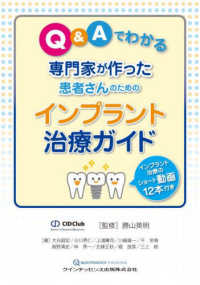Full Description
Nanotechnology in Cosmeceuticals: Advances, Challenges and Future Perspectives explores the fundamental principles of nanotechnology in cosmetics required to understand chemistry related formulation and the dermatological effects of these products. This book by provides an in-depth analysis of nanotechnology in cosmeceuticals, covering pharmaceutical, chemical, and toxicological aspects. The contents of this book are divided in seven parts. The first lays the foundations of cosmetics, and nanotechnology applications. The second part focuses no nano-metaloxides, including titanium, zinc, gold, silver and others. The third part covers carbon-based products in cosmeceuticals with chapters on graphene, nano-hydroxyapatite, and general carbon-based products. The next part focuses on nano-organics, nanocellulose and biodegradable materials. Part five is dedicated to formulations of liposomes, lipids in drug delivery. Part six covers recent trends, advances, applications and progress of nanotechnology and nano products in cosmeceuticals. The final part focuses on safety and toxicity aspects of nano-cosmeceuticals. Nanotechnology in Cosmeceuticals: Advances, Challenges and Future Perspectives is an ideal reference for pharmacologists, cosmetic scientists, and chemists in academic research and corporate settings looking into leveraging nanoscience to improve the performance of cosmetics. Dermatologists and food scientists may also benefit from the foundational content present in the first part of the book.
Contents
Section 1: Introduction, Fundamentals and Overview of Cosmetics
1. Introduction and Outline of Cosmetics (Industry and Market)
2. Role of Nanotechnology in Cosmetics
3. Overview of Inorganic and Organic Nanoparticles in Cosmetic Applications
4. Antiaging Cosmeceutical Preparations
5. Use of Herbals in Cosmeceutical Preparations
Section 2: Significance and Role of Nano-metaloxides for the Cosmetics Applications
6. Prospective of Titanium Dioxide in Skin Care Creams and Lotions
7. Prospective of Zinc Oxide in Skincare Protection
8. Significance of Various Nanometal Oxides in Cosmetics Applications
9. Advances Of Gold and Silver Nanoparticles for Various Skincare/Cosmetics
Section 3: Influence Of Carbon-Based Products in Cosmeceuticals Applications
10. Graphene And Its Derivatives in Cosmetic Applications
11. Carbon Based Products in Cosmeceuticals Applications
12. Advances And Prospective of Nano-Hydroxyapatite in Oral Cosmetics
Sections 4: Overview Of Nano-Organics, Nanocellulose and Biodegradable Materials in Cosmeceuticals Products
13. Overview Of Nano-Organic in Cosmetics
14. Role And Prospective of Biodegradable Nanocomponents in Cosmeceuticals
15. Potential applications and prospects of nanocellulose in cosmetics
16. Microemulsions and Nano-emulsions for Cosmetic Applications
Section 5: Formulations of liposomes, lipids in drug delivery, capsules in cosmeceuticals and health care products
17. Overview of nano-formulations used in Cosmetics
18. Nanodrug delivery systems and applications in cosmetics
19. Nanoliposomes in skincare products
20. Nanostructures lipids in cosmetics and drug delivery
21. Prospectus and applications of nano-capsules in cosmeceuticals
22. Nanoparticles and technology in hair care products
23. Nanoparticles and technology in oral care products
24. Green nanotechnology in cosmeceuticals
Section 6: Recent trends, advances, application and progress of Nanotechnology and nano products in cosmeceuticals
25. Prospectus and applications of nanoemulsions in cosmeceuticals
26. Recent advances and progress of nanomaterials in cosmeceuticals
27. Application of micro and nano needles in cosmeceuticals
28. Prospects of nanotechnology in cosmeceuticals
29. Characterization/technological advances/scale-up infrastructure in nano-based cosmeceuticals
Section 7: Safety and Toxicity Concerns of Nano-cosmeceuticals
30. Health and Toxicity Associated with Nano-cosmeceuticals
31. Regulations in Cosmetics
32. Quality Control of Nano Cosmeceutical Products
33. How Safe is Cosmetics Ingredients?






